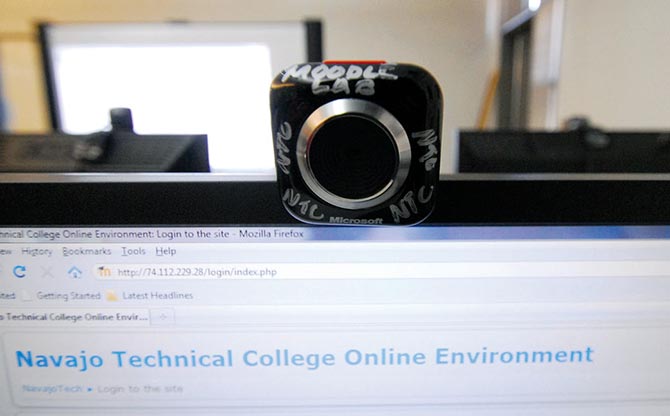Navajo Tech bridges digital divide with online classes

(Special to the Times - Donovan Quintero)
A webcam used for online classes rests on top of a computer monitor June 23 at the Navajo Technical College in Crownpoint.
By Alastair Lee Bitsoi
Navajo Times
CROWNPOINT, July 9, 2011

(Special to the Times - Donovan Quintero)
A Navajo Technical College student, who uses a computer to do his online classes, works on his assignment June 23 in Crownpoint.
Who would have thought Navajo Technical College could lead the way in bridging the digital divide on the Navajo Nation and bringing education directly into the homes of its students via online classes?
The little trade school in Eastern Navajo is better known for hands-on classes like carpentry and cooking, but it's grown far beyond that.
"A lot of people are impressed when they come visit Navajo Tech," said Elearning Coordinator Tammy Bitsilly. "When people come here they're overwhelmed."
"Overwhelming" is probably the best word to describe Navajo Tech's transformation into a tech-savvy institution able to serve students throughout the Navajo Nation, particularly with its recent offering of Elearning or online classes.
Since the inception of Elearning last year, the school has attracted hundreds of students from as far away as Farmington, Las Cruces and Socorro, N.M., Tuba City, and Montezuma Creek, Utah, she said.
Online classes are open to students who live closer to campus as well, she said.
For the summer session, Navajo Tech has offered online classes in Technical Math I, English Freshman Composition and Geographic Information Systems I and II. There are also Web-enhanced courses in Technical Math II, Elements of Chemistry, Introduction to Computers, and Programming.
At last count, Bitsilly said, there were approximately 122 students enrolled in online classes for the summer session. Over 150 students registered for online classes in the spring semester.
"Our Elearning is growing," said Jason Arviso, Navajo Tech's director of institutional development. "In itself we're initially learning what it takes to teach online. Time management is a key factor of taking online classes."
In addition to full-time and part-time students, online classes attract people who may need to fulfill educational requirements for their job.
Research has indicated that Elearning is a positive learning environment for Native Americans because they generally are visual learners, added Bitsilly.
Navajo Tech uses Moodle, an open source online teaching system for science, technology, engineering and math education.
Moodle is similar to WebCT or Blackboard, which are systems traditionally used by four-year institutions like Fort Lewis College, Northern Arizona University, or University of New Mexico-Gallup.
Moodle training is required for all students who enroll at Navajo Tech.
Navajo Tech's Elearning classes grew out of the Internet to the Hogan Project, which began in 2006 and created a hub at the school from which high-speed Internet access is being extended to 31 chapter houses and surrounding homes and public facilities in New Mexico.
Writer Tom Davis described its significance in a chapter of "Ancient Wisdom, Modern Science: The Integration of Native Knowledge in Math and Science at Tribally Controlled Colleges and Universities."
"Multi-faceted, the project has human, economic, educational, medical, public safety, research, and cultural aspects," Davis wrote. "It is designed to deploy cutting edge technologies in communities that in the past have acquired those technologies only after they have become commodities."
Instructors who teach the online classes can be based anywhere, and range as far away as Milwaukee, Wis.
Joann Becenti, an instructor who teaches business, computers, and psychology, said the online classes are convenient tools for students.
"Students don't have to travel to get their education, and do it on their own time," Becenti said. "If they want to get up at 2 a.m. in the morning they can do it."
"It gives me the chance to stay at home," said Linda Mud, 44, of Coyote Canyon, N.M. "It's also an opportunity to take more classes ... because it shortens the academic path to attaining a degree."
Mud has enrolled in four online classes since the program became available, and has earned an associate's degree in business administration. She is currently working toward an associate's degree in the law advocate program.
Tymeko Morgan, 22, of Crownpoint, agrees that "the benefit of online classes is to do it on your own time, own pace. Computer skills are also built."
Morgan has taken two online classes and is on track to earn an associate's degree in information technology.
College officials encourage students who enroll in the online classes to make sure they've got a computer and Internet resources at home. And if they don't have those resources at home, to find a place that does.
On-campus computer labs are available, for instance, although they are not open round the clock, Bitsilly said. Most public libraries also have computers available for patrons to use but often limit the amount of time in a single session because of high demand.
Various universities now offer online courses, and they are a popular way for Navajos to further their education, said Andrew M. Tah, Navajo Nation superintendent of schools.
"Many students have inadequate transportation and limited resources to further their education," he said.
"I commend Navajo Technical College in their expansion of their Elearning program," Tah said. "This will benefit students in achieving their goals and help them obtain their degree to help further our Navajo Nation."
The Office of Navajo Nation Scholarship and Financial Assistance awarded financial aid to 397 students to attend Navajo Tech during the 2010-11 academic year, said Carolyn Calvin, ONNSFA public information officer.
Online students can qualify for aid as along as they maintain full-time or part-time status, she said.
Information: Tammy K. Bitsilly, Elearning coordinator, 505-786-4152 or tbitsilly@navajotech.edu.

